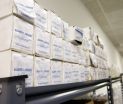(Press-News.org) When rabbis from the Orthodox Union started finding worms in cans of sardines and capelin eggs, they turned to scientists at the American Museum of Natural History to answer a culturally significant dietary question: could these foods still be considered kosher?
Using a technique called "DNA barcoding" at the Museum's Sackler Institute for Comparative Genomics, researchers identified the species and life cycles of the parasitic worms to determine whether the food's preparation violated Jewish dietary laws. The results, which were recently published online in the Journal of Parasitology, show that although the food contains a handful of species of roundworms, it is kosher.
"About 75 percent of all pre-packaged food has a kosher certification," said Mark Siddall, a curator in the Museum's Division of Invertebrate Zoology. "Many people, not just those in the Jewish community, look for this certification as a symbol of quality assurance in food preparation. If you're a food provider and you lose that certification, you're going to take a large hit."
The study began last March, when rabbinical experts from the Orthodox Union, the largest organization that certifies food products for the Jewish community, brought a variety of kosher-certified sardines and capelin eggs to the Museum. Their concern: the presence of the worms might be a sign that intestinal contents were allowed to mix with sardine meat or preserved capelin eggs during food preparation. If that were the case, kosher certification would be compromised.
The key to determining whether the canned food was improperly handled is in the worms' life cycles, Siddall said. "Some species of worms live in the muscles of fish when they're in the larval stage," he said. "Other species live in the fish's intestines when they're adults. We already know the life cycles for these parasites, so all we have to do is figure out what species were present in the canned food."
To do this, researchers used genetic barcoding, a technology based on a relatively short region of a gene in the mitochondrion, an energy-producing structure located outside of the cell's nucleus, that allows researchers to efficiently identify the species from which a piece of meat—or even a leather handbag—came from.
Work by Museum scientists has long included and promoted this technique, which has identified the presence of endangered whales in Asian markets, documented fraud in the labeling of tuna, and determined the species of animals on sale in African bushmeat markets.
In this case, the scientists identified a handful of different nematode species, none of which are known to live in the guts of fish during their lifecycles—therefore, there's no evidence of intestinal worms co-mingling with the fish meat or eggs.
As a result, the Orthodox Union issued a decision that the food remains kosher.
"To our knowledge, this is the first application of DNA barcoding to an obviously cultural concern," said Sebastian Kvist, one of the paper's authors and a student in the Museum's Richard Gilder Graduate School. "This paper really exemplifies what science is all about—helping people."
INFORMATION:
Other authors include Anna Phillips, from the University of Connecticut, and Alejandro Oceguera-Figuero, from the National Autonomous University of Mexico.
Funding for the Museum's DNA Barcoding Initiative is provided by the Alfred P. Sloan Foundation and the Richard Lounsbery Foundation.
END
Cyclone Giovanna made landfall in eastern Madagascar very early on February 14 and continues tracking in a southwestern direction toward the Mozambique Channel. NASA's Aqua satellite captured an image when Giovanna's center was close to the capital city of Antananarivo, and NASA's TRMM satellite saw powerful towering thunderstorms around its center before it made landfall.
According to BBC News, Giovanna made landfall near the eastern port city of Toamasina with winds gusting to 120 mph (194km). Giovanna brought heavy rain, and its strong winds flattened trees. Storm ...
We like to think of ourselves as rational creatures, absorbing information, weighing it carefully, and making thoughtful decisions. But, as it turns out, we're kidding ourselves. Over the past few decades, scientists have shown there are many different internal and external factors influencing how we think, feel, communicate, and make decisions at any given moment.
One particularly powerful influence may be our own bodies, according to new research reviewed in the December issue of Current Directions in Psychological Science, a journal of the Association for Psychological ...
Tropical Cyclone Jasmine is still lingering near the island nation of Tonga in the South Pacific and was captured in an infrared image from NASA's Aqua satellite. Jasmine is bringing gusty winds and heavy rainfall to some of Tonga's islands.
When Aqua flew over Cyclone Jasmine on February 14, 2012 at 1241 UTC (7:41 a.m.), the Moderate Resolution Imaging Spectroradiometer (MODIS) instrument captured an infrared image of its clouds. The image showed the strongest thunderstorms and heaviest rainfall appear to be on the northeastern quadrant of the storm.
A gale warning ...
Known as a leader in the field of allergy bedding, AchooAllergy.com's Allergy Armor bedding line has been featured on the award-winning television show The Doctors and is recommended by over 4000 physicians annually. Extending this innovative line of bedding, AchooAllergy now offers another product aimed at improving the lives of allergy sufferers - the Allergy Armor Organic Cotton Blanket.
Specially designed and crafted for individuals with asthma, allergies, Multiple Chemical Sensitivity (MCS), the Allergy Armor organic cotton blanket is made with un-dyed, organically ...
"The sensor provides opportunities to make specific and detailed diagnostics for a particular patient and to tailor care based on very objective and quantitative measures," said Eric H. Ledet, PhD, Assistant Professor, Rensselaer Polytechnic Institute.
"This highly unique sensor is very small (4 mm diameter and 500 microns thick), is wireless, batteryless, and requires no telemetry within the body. Its simplicity makes it less prone to failure and very inexpensive to produce," Dr. Ledet explained.
The orthopaedic implant acts as a carrier for the sensor. The wireless ...
Although only 2 percent of the American population that undergo total joint replacement surgery will suffer an infection, half of those infections are from MRSA. The results of a MRSA infection after a total joint replacement can be devastating. Currently, there is no effective treatment for MRSA-infected implants. With the increasing incidence of total joint replacement surgeries, the prevalence of MRSA-infected implants is expected to rise.
A team of investigators from the University of Rochester Medical Center has developed a vaccine that can prevent bacterial ...
MATERIALS -- Next-generation electronics . . .
Changing the behavior of a material isn't big magic – it's nanoscale chemistry. Alejandro Lopez-Bezanilla used the computing power of Oak Ridge National Laboratory's Jaguar supercomputer, America's fastest, to study the effects of adding oxygen, sulfur and hydrogen to nanoribbons made of boron nitride. The added elements changed the behavior of boron nitride – a good insulator – into that of a metal. That makes the material promising for faster computer chips and smarter cell phones. Stable, inexpensive boron nitride can ...
According to Timothy E. Hewett, PhD, FACSM, Director of Research, Ohio State University Sports Health and Performance Institute and Cincinnati Children's Sports Medicine Biodynamics Center, that injury occurs due to a tri-planar multi-dimensional combination of factors.
"Sometimes in science we have a lot of clinical expertise and a lot of engineering expertise but we don't have much—what I call--'common sense-pertise'."
"Is it just anterior translation that strains and tears the ACL? Is it just knee abduction or that inward motion that tears the ACL? Is it just ...
A person has a tumor removed from her femur. A soldier is struck by an improvised explosive device and loses a portion of his tibia. A child undergoes chemotherapy for osteosarcoma but part of the bone dies as a result.
Every year, millions of Americans sustain fractures that don't heal or lose bone that isn't successfully grafted. But a study presented at the Orthopaedic Research Society (ORS) 2012 Annual Meeting in San Francisco offers new hope for those who sustain these traumas.
Orthopaedic researchers with the University of California, San Francisco (UCSF), ...
In a first-of-its-kind study in Canada, Kevin Bainey of the Faculty of Medicine & Dentistry has discovered that South Asians who live in Alberta with coronary disease experience a lower quality of life.
This adds to prior data that this group lives with more severe disease.
Using the APPROACH registry, which captures information about all patients who undergo a coronary angiogram in Alberta, the research team analyzed data about quality of life and health status of this population. The validated survey results showed that South Asians' overall quality of life scored ...


